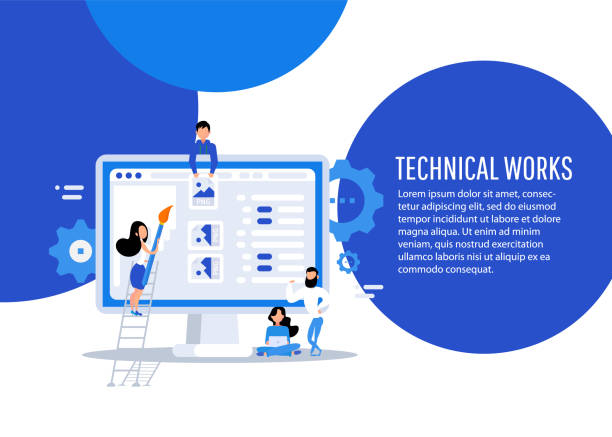An Introduction to the World of Multilingual Websites

In the era of globalization, websites have transcended geographical boundaries and become powerful tools for connecting with audiences worldwide.
Multilingual website design is no longer a luxury option; it has become a necessity for businesses looking to expand their presence in international markets.
This approach allows you to present your content in various languages, thereby connecting with a wider range of users.
The main goal of a multilingual website is to provide a native and comfortable experience for every visitor, regardless of their mother tongue.
This process involves accurate translation, not just word-for-word content, but also localization to adapt to cultures and regional differences.
A monolingual website, no matter how high-quality its content, can never attract global audiences as effectively as a multilingual platform.
This is a very important step in increasing accessibility and penetration into international markets.
Does your current corporate website present a worthy image of your brand and attract new customers?
If not, transform this challenge into an opportunity with RasaWeb’s professional corporate website design services.
✅ Significantly improves your brand’s credibility and image.
✅ Paves the way for attracting new leads and and new customers.
⚡ For free and specialized consultation, contact RasaWeb now!
Why Do We Need Multilingual Website Design? Examining Reasons and Advantages

The need for multilingual website design stems from several reasons, all leading to improved business performance and increased profitability.
The first and most important reason is increased access to global markets.
By providing content in different languages, you will be able to reach customers who do not speak English or your website’s primary language.
This means a potential increase in customer base and revenue growth.
The second advantage is strengthening brand credibility and professionalism.
A multilingual website shows that your business cares about global audiences and strives to provide them with a native experience.
This approach significantly helps in building customer trust and loyalty.
Furthermore, improved international SEO is also a significant benefit.
Search engines index multilingual websites better, which leads to an improved ranking in international search results.
Finally, analytics show that users are more inclined to purchase from or interact with websites presented in their native language, which in turn means higher conversion rates and increased profitability.
Technical Considerations in Implementing Multilingual Website Design

Multilingual website design goes beyond mere text translation and requires precise technical considerations to ensure correct functionality and optimal user experience.
One of the most important aspects is URL structure.
There are three main methods for this: subdirectories (example.com/fa/), subdomains (fa.example.com), and country code top-level domains (ccTLDs) (example.fr).
Each of these methods has its own advantages and disadvantages in terms of SEO and management.
The use of the hreflang tag is also vital.
This tag helps search engines display the correct language version of the website to users based on their location and language.
Correct charset settings (usually UTF-8) are essential for supporting various language characters.
Furthermore, special attention must be paid to Right-to-Left (RTL) support for languages like Persian or Arabic, which involves changing the layout direction of page elements.
Optimizing images and media for different languages and ensuring suitable loading speed worldwide are other technical considerations.
| Method | URL Example | Advantages | Disadvantages |
|---|---|---|---|
| Subdirectory | example.com/fa/ |
Easy SEO management, lower cost | May be less appealing to some native users |
| Subdomain | fa.example.com |
Better content separation, greater sense of localization | Slightly more complex SEO management, requires DNS settings |
| Country Code Top-Level Domain (ccTLD) | example.fr |
Most powerful for local SEO, highest sense of localization | High cost, more complex management, requires purchasing multiple domains |
Content and Translation Management Strategies in Multilingual Website Design

One of the biggest challenges in multilingual website design is efficient content and translation process management.
Mere machine translation is often insufficient and can lead to significant errors or incorrect meaning transfer.
Using professional translators familiar with the culture and linguistic nuances of the target audience is of critical importance.
Additionally, a suitable Content Management System (CMS) must be chosen that supports strong multilingual capabilities and allows content to be easily added, edited, and updated for different languages.
This system should facilitate easy management of translated strings, images, and other visual elements for each language.
Planning for content updates across all languages is also essential; new content should be translated and published simultaneously or shortly after the original version is released, ensuring that all website versions remain up-to-date and relevant.
Failure to observe this can lead to content inconsistency and an undesirable user experience.
Are you frustrated with your online store’s low conversion rate?
RasaWeb is your definitive solution with professional e-commerce website design!
✅ Increase your sales and revenue
✅ Unrivaled user experience for your customers
⚡ Get a free consultation now!
Search Engine Optimization (SEO) for Multilingual Websites

The success of a multilingual website design largely depends on its international SEO strategy.
This goes beyond simply translating keywords and requires separate keyword research for each language and region.
Search queries and user behavior can vary significantly across different cultures and languages.
Proper use of the hreflang tag, as mentioned in the technical section, helps search engines display the correct language versions of your pages to relevant users.
Furthermore, you should optimize your backlink profile for each language, meaning building links from local and reputable websites in each country or region.
Website loading speed is also crucial for international SEO; web hosting and Content Delivery Network (CDN) should be selected to optimize access speed for users worldwide.
Attention to technical SEO, Local SEO, and site structure, in a way that is understandable to search engine crawlers, is of high importance.
User Experience (UX) in Multilingual Website Design: Challenges and Solutions

User Experience (UX) plays a vital role in multilingual website design.
Regardless of how many languages the content is presented in, it must be ensured that users can easily switch between languages and find their desired content.
The position and appearance of the language selection button or menu are crucial; this button should be easily visible and accessible.
Additionally, the design must be flexible to manage differences in text length and language orientation (such as Right-to-Left or Left-to-Right).
For example, the design for Persian or Arabic languages should be optimized for Right-to-Left orientation from the outset.
Images and icons must also be culturally appropriate and not convey different messages in various cultures.
User testing with native speakers from each target language is highly recommended to identify and resolve potential UX issues.
Providing a seamless and localized user experience will increase user satisfaction and greater engagement with your website.
Useful Tools and Platforms for Multilingual Website Design

To facilitate the multilingual website design process, numerous tools and platforms are available, each with its specific features and capabilities.
Content Management Systems (CMS) like WordPress (with plugins such as WPML or Polylang), Joomla, and Drupal are among the most popular options, offering strong support for developing multilingual websites.
These platforms provide tools for managing translations, multilingual SEO, and template customization for different languages.
In addition to CMSs, specialized website translation platforms like Weglot or TranslatePress also exist, which perform translation automatically or semi-automatically and are compatible with most CMSs.
For larger and more complex projects, dedicated Translation Management Systems (TMS) such as MemoQ or SDL Trados are also used, helping manage large volumes of translated content and facilitating collaboration among translation teams.
The choice of the right tool depends on the budget, project scale, and the technical expertise of the development team.
| Platform/Plugin Name | Type | Compatibility with Main CMS | Key Features |
|---|---|---|---|
| WPML | WordPress Plugin | WordPress | Comprehensive, advanced translation management, WooCommerce support |
| Polylang | WordPress Plugin | WordPress | Free and lightweight, easy to use |
| Weglot | SaaS Translation Platform | WordPress, Shopify, Magento, etc. | Initial automatic translation, visual editor, multilingual SEO |
| Drupal (Core Multilingual) | CMS | Drupal itself | Strong multilingual capabilities in core, suitable for complex projects |
Common Mistakes in Multilingual Website Design and How to Avoid Them
![]()
On the path to multilingual website design, common mistakes can harm your efforts.
One of the biggest mistakes is ignoring cultural localization and relying solely on literal translation.
This can lead to misunderstandings or even unintentional offense.
Every language has its specific idioms and nuances that may not translate meaningfully into another language.
Another mistake is the lack of proper SEO optimization for each language, which prevents the website from appearing in international search results.
Failure to use the hreflang tag or its incorrect configuration is one of the most common of these errors.
Furthermore, some businesses forget to translate all content, including error messages, forms, and Call to Action buttons, which disrupts the user experience.
Slow page loading speed for international users, due to unsuitable server selection or lack of CDN use, is also a common problem.
To avoid these issues, precise planning, hiring professional translation and international SEO specialists, and regular website testing by native users are essential.
Are you bothered by losing customers due to your online store’s outdated appearance or slow speed? RasaWeb’s expert team solves these problems with professional e-commerce website design!
✅ Increase customer trust and your brand’s credibility
✅ Stunning speed and excellent user experience
Get a free consultation with RasaWeb now ⚡
The Future of Global Web Presence: Multilingual Website Design

The future of global web presence is increasingly moving towards personalization and localization, and this is where multilingual website design plays a pivotal role.
With advancements in AI and machine learning technologies, machine translation processes are expected to become more accurate and natural, but they are still not a complete substitute for human translators; rather, they serve as tools to accelerate the work.
Another trend is the increasing importance of voice search.
Users are searching more than ever with voice commands in their local languages, which highlights the need for content optimized for voice search in different languages.
Furthermore, web development platforms and tools are expected to offer multilingual capabilities natively, without the need for complex plugins, which will simplify the development process.
Focusing on native user experience and content personalization based on each user’s cultural and linguistic preferences will be among the key future trends that transform multilingual websites into more powerful tools for global communication.
Conclusion and Next Steps towards Successful Multilingual Website Design

Ultimately, multilingual website design is a strategic investment for any business seeking to expand its horizons in international markets.
This complex but rewarding process requires a comprehensive approach that includes meticulous planning, adherence to technical considerations, efficient content management, SEO optimization, and deep attention to user experience.
By following these tips, you can establish a strong and effective online presence worldwide.
Your next steps should include a thorough assessment of your business needs, selecting appropriate platforms and tools, collaborating with native translators and SEO specialists, and continuous website testing and optimization.
Remember that a successful multilingual website is not a one-time project but a continuous process of updating and adapting to consistently meet the evolving needs of your global audience.
With this approach, you can unlock the full potential of the global market.
Frequently Asked Questions
| Question | Answer |
|---|---|
| What is multilingual website design? | The process of creating a website whose content is available to users in more than one language. |
| Why should I make my website multilingual? | To reach a wider global audience, improve user experience for non-native speakers, and increase sales or engagement. |
| What are the methods for implementing a multilingual website? | Using subdomains, subdirectories, or URL parameters, or using different Top-Level Domains (TLDs) for each language. |
| Which method is better for SEO? | Generally, using subdirectories (e.g., example.com/fa/) is recommended for SEO, as they share the main domain’s authority. |
| What is the hreflang tag and what is its use? | The hreflang tag is an HTML attribute that helps search engines understand which version of a page is suitable for a specific language or region. |
| Is machine translation sufficient for multilingual website content? | Usually not. For a good user experience and to maintain credibility, professional translation and content localization are essential. |
| What does Localization mean? | The process of adapting website content, design, and functionality to the culture, language, currency, and other specific characteristics of a target region or country. |
| What is the importance of language selection in multilingual website design? | Users should be allowed to easily choose their desired language, usually via a clear button or menu in the website header. |
| What challenges exist in multilingual website design? | Managing content in different languages, maintaining design and UX consistency, multilingual SEO, and translation and maintenance costs. |
| What features should a suitable Content Management System (CMS) for a multilingual website have? | It should allow easy management of content in different languages, support multilingual URL structures, and have related translation and localization plugins. |
And other services of RasaWeb Advertising Agency in the field of advertising
Smart Advertising Campaign: A creative platform for improving customer acquisition with Google Ads management.
Smart Advertising Campaign: An effective tool for analyzing customer behavior with precise audience targeting.
Smart Conversion Rate Optimization: Transform user engagement by optimizing key pages.
Smart Sales Automation: A fast and efficient solution to increase click-through rates by focusing on marketing automation.
Smart Advertorial: A combination of creativity and technology for digital branding through intelligent data analysis.
And over hundreds of other services in the field of internet advertising, advertising consultation, and organizational solutions
Internet Advertising | Advertising Strategy | Advertorial
Sources
Multilingual Website Design and Its Advantages
Multilingual Website Design; Its Advantages and Disadvantages
Advantages and Challenges of Multilingual Website Design
How to Design a Multilingual Website?
? Are you looking for a big leap in the online world? RasaWeb Afarin creates a powerful and effective presence for your business by providing innovative digital marketing solutions, including fast website design.
📍 Tehran, Mirdamad Street, next to Bank Markazi, Southern Kazeroun Alley, Ramin Alley, No. 6


